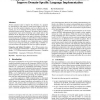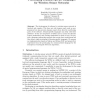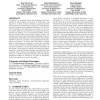JCS
2002
14 years 2 months ago
2002
We describe the use of a domain-specific language (DSL) for expressing critical design values and constraints in an intrusion detection application. Through the use of this specia...
IEE
2008
14 years 3 months ago
2008
The trend toward domain-specific languages leads to an ever-growing plethora of highly specialized languages. Developers of such languages focus on their specific domains rather t...
AOSD
2010
ACM
14 years 3 months ago
2010
ACM
Embedded domain-specific languages (EDSLs) are said to be easier to compose than DSLs that are implemented by preprocessors. However, existing approaches focus on composition scen...
ICFP
2010
ACM
14 years 4 months ago
2010
ACM
Partial evaluation aims to improve the efficiency of a program by specialising it with respect to some known inputs. In this paper, we show that partial evaluation can be an effec...
MLMTA
2007
14 years 4 months ago
2007
- While grammar inference (or grammar induction) has found extensive application in the areas of robotics, computational biology, speech and pattern recognition, its application to...
MODELLIERUNG
2008
14 years 4 months ago
2008
The development of software for wireless sensor networks is involved and complex. This does not only impose much work on programmers but also prevents domain experts from directly ...
DGO
2008
14 years 4 months ago
2008
UrbanSim is a modeling system for simulating the development of urban regions over periods of 20-30 years. Its purpose is to help evaluate alternative proposed policies and transp...
UML
2005
Springer
14 years 8 months ago
2005
Springer
Abstract. Domain-Specific Languages (DSL) offer many advantages over general languages, but their narrow scope makes them really effective only in very focused domains, for example...
SCCC
2008
IEEE
14 years 9 months ago
2008
IEEE
Domain-Specific Languages (DSLs) are high level languages defined for combining expressivity and simplicity by means of constructs which are close to the problem domain and distan...
ICFP
2008
ACM
15 years 3 months ago
2008
ACM
This paper exhibits the power of programming with dependent types by dint of embedding three domain-specific languages: Cryptol, a language for cryptographic protocols; a small da...



